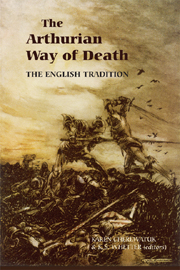Book contents
- Frontmatter
- Contents
- Illustrations and Tables
- Dedication
- List of Contributors
- Introduction
- Part I The early Tradition in england
- Part II Middle English Romance and Malory
- Part III Medieval Influence and Modern Arthuriana
- 10 Arthurian Exits: Alone, Together, or None of the Above
- 11 Woman as Agent of Death in Tennyson's Idylls of the King
- 12 Death as ‘Neglect of Duty’ in Howard Pyle's The Story of the Grail and the Passing of Arthur
- 13 Death and the ‘grimly voice“ in David Jones's In Parenthesis
- 14 Roll the Final Credits: Some Notes on Cinematic Depictions of the Death of Arthur
- Index
- Arthurian Studies
14 - Roll the Final Credits: Some Notes on Cinematic Depictions of the Death of Arthur
from Part III - Medieval Influence and Modern Arthuriana
Published online by Cambridge University Press: 12 September 2012
- Frontmatter
- Contents
- Illustrations and Tables
- Dedication
- List of Contributors
- Introduction
- Part I The early Tradition in england
- Part II Middle English Romance and Malory
- Part III Medieval Influence and Modern Arthuriana
- 10 Arthurian Exits: Alone, Together, or None of the Above
- 11 Woman as Agent of Death in Tennyson's Idylls of the King
- 12 Death as ‘Neglect of Duty’ in Howard Pyle's The Story of the Grail and the Passing of Arthur
- 13 Death and the ‘grimly voice“ in David Jones's In Parenthesis
- 14 Roll the Final Credits: Some Notes on Cinematic Depictions of the Death of Arthur
- Index
- Arthurian Studies
Summary
– For Alan and Barbara Tepa Lupack, with thanks
‘Comforte thyselff,’ seyde the kynge, ‘and do as well as thou mayste, for in me ys no truste for to truste in. For I [wyll] into the vale of Avylyon to hele me of my grevous wounde. And if thou here nevermore of me, pray for my soule!’ … Thus of Arthur I fynde no more wrytten in bokis that bene auctorysed, nothir more of the verry sertaynté of hys dethe harde I never rede, but thus was he lad away in a shyp wherein were three quenys. … [Y]et som men say in many p[art]ys of Inglonde that kynge Arthure ys nat dede, but h[ad] by the wyll of oure Lorde Jesu into another place; and men say that he shall com agayne, and he shall wynne the Holy Crosse. Yet I woll nat say that hit shall be so, but rather I wolde sey: here in thys worlde he chaunged hys lyff. And many men say that there ys wrytten upon the tumbe thys [vers]: Hic iacet Arthurus, Rex quondam Rexque futurus.
Sir Thomas Malory's account of the life and death of Arthur stands as the pivotal text between the medieval and the post-medieval receptions of the Arthuriad. Malory himself synthesizes previous Celtic, English, and French traditions of the life and legend of the once and future king, and Malory is often named as putative source for modern and post-modern, especially cinematic, retellings of that life and legend.
- Type
- Chapter
- Information
- The Arthurian Way of DeathThe English Tradition, pp. 241 - 248Publisher: Boydell & BrewerPrint publication year: 2009



